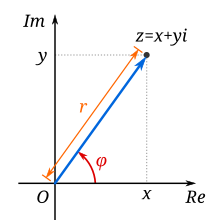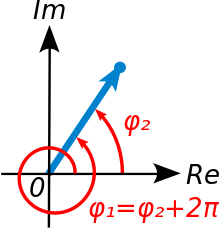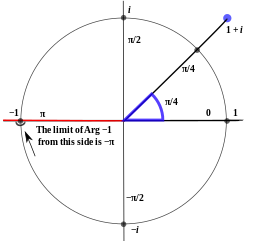複素数平面 での複素数の絶対値 r , 偏角 φ 。数学 において、複素数 の偏角 (へんかく、英 : argument of complex )とは、複素数平面 上で複素数が表す点の動径 が表す一般角 のことである。複素数 z の偏角は記号で arg z で表す。偏角はラジアン で表す。
複素数を極形式表示することで、絶対値 と偏角が得られる。これにより、複素数の乗除が簡明に行うことができる。
複素数に対する偏角は、2π の任意の整数倍を足す分だけ表し方がある。つまり、多価関数 である。そこで表示を一意にするには、主値 区間 (−π , π ] などに制限する。
2π の任意の整数倍の差を除いて次の等式が成り立つ:
arg zw ≡ arg z + arg w arg z / w z − arg w (何れも mod 2π )
偏角 φ の2つの選び方 複素数 z = x + yi 偏角 は、arg z と書かれ、正の実 軸 から動径 Oz までの角度を反時計回りに測った角度である。弧度法 で表示する。時計回りに測ると負になる。
複素数に対する偏角の表示を一意にするために、主値 区間 (−π , π ] に制限する。[0, 2π ) にすることもある。
主値を (−π , π ] にすると、逆正接関数 tan−1 を用いて次のように表せる:
arg
z
=
{
tan
−
1
y
x
(
x
>
0
)
tan
−
1
y
x
+
π
(
x
<
0
∧
y
≧
0
)
tan
−
1
y
x
−
π
(
x
<
0
∧
y
<
0
)
π
2
(
x
=
0
∧
y
>
0
)
−
π
2
(
x
=
0
∧
y
<
0
)
indeterminate
(
x
=
y
=
0
)
{\displaystyle \arg z={\begin{cases}\tan ^{-1}{\dfrac {y}{x}}&(x>0)\\[0.1em]\tan ^{-1}{\dfrac {y}{x}}+\pi &(x<0\,\land \,y\geqq 0)\\[0.1em]\tan ^{-1}{\dfrac {y}{x}}-\pi &(x<0\,\land \,y<0)\\[0.1em]{\dfrac {\pi }{2}}&(x=0\,\land \,y>0)\\[0.1em]-{\dfrac {\pi }{2}}&(x=0\,\land \,y<0)\\[0.1em]{\text{indeterminate}}&(x=y=0)\end{cases}}}
上記の式には条件分岐が多数あるが、符号関数 sgn やヘヴィサイドの階段関数 H (x )
arg
z
=
{
tan
−
1
y
x
+
1
−
sgn
x
2
(
1
+
sgn
y
−
|
sgn
y
|
)
π
(
x
≠
0
)
(
sgn
y
)
π
2
(
x
=
0
∧
y
≠
0
)
indeterminate
(
x
=
y
=
0
)
=
{
tan
−
1
y
x
+
{
1
−
H
(
x
)
}
{
2
H
1
(
y
)
−
1
}
π
(
x
≠
0
)
(
sgn
y
)
π
2
(
x
=
0
∧
y
≠
0
)
indeterminate
(
x
=
y
=
0
)
{\displaystyle {\begin{aligned}\arg z&={\begin{cases}\tan ^{-1}{\dfrac {y}{x}}+{\dfrac {1-\operatorname {sgn} x}{2}}(1+\operatorname {sgn} y-|\operatorname {sgn} y|)\pi &(x\neq 0)\\[0.1em](\operatorname {sgn} y){\dfrac {\pi }{2}}&(x=0\,\land \,y\neq 0)\\[0.1em]{\text{indeterminate}}&(x=y=0)\end{cases}}\\&={\begin{cases}\tan ^{-1}{\dfrac {y}{x}}+\{1-H(x)\}\{2H_{1}(y)-1\}\pi &(x\neq 0)\\[0.1em](\operatorname {sgn} y){\dfrac {\pi }{2}}&(x=0\,\land \,y\neq 0)\\[0.1em]{\text{indeterminate}}&(x=y=0)\end{cases}}\end{aligned}}}
0 × (0 除算を含む式) = 0 と形式的に考えることで、更にまとめることもできる:
arg
z
=
{
|
sgn
x
|
tan
−
1
y
x
+
1
−
sgn
x
2
(
1
+
sgn
y
−
|
sgn
y
|
)
π
(
x
≠
0
∨
y
≠
0
)
indeterminate
(
x
=
y
=
0
)
=
{
|
sgn
x
|
tan
−
1
y
x
+
{
1
−
H
1
/
2
(
x
)
}
{
2
H
1
(
y
)
−
1
}
π
(
x
≠
0
∨
y
≠
0
)
indeterminate
(
x
=
y
=
0
)
{\displaystyle {\begin{aligned}\arg z&={\begin{cases}|\operatorname {sgn} x|\tan ^{-1}{\dfrac {y}{x}}+{\dfrac {1-\operatorname {sgn} x}{2}}(1+\operatorname {sgn} y-|\operatorname {sgn} y|)\pi &(x\neq 0\,\lor \,y\neq 0)\\[0.1em]{\text{indeterminate}}&(x=y=0)\end{cases}}\\&={\begin{cases}|\operatorname {sgn} x|\tan ^{-1}{\dfrac {y}{x}}+\{1-H_{1/2}(x)\}\{2H_{1}(y)-1\}\pi &(x\neq 0\,\lor \,y\neq 0)\\[0.1em]{\text{indeterminate}}&(x=y=0)\end{cases}}\end{aligned}}}
あるいは、逆余弦関数 cos−1 や逆正弦関数 sin−1 を用いて次のように表すこともできる:
arg
z
=
{
(
1
+
sgn
y
−
|
sgn
y
|
)
cos
−
1
x
|
z
|
(
x
≠
0
∨
y
≠
0
)
indeterminate
(
x
=
y
=
0
)
=
{
{
2
H
1
(
y
)
−
1
}
cos
−
1
x
|
z
|
(
x
≠
0
∨
y
≠
0
)
indeterminate
(
x
=
y
=
0
)
{\displaystyle {\begin{aligned}\arg z&={\begin{cases}(1+\operatorname {sgn} y-|\operatorname {sgn} y|)\cos ^{-1}{\dfrac {x}{|z|}}&(x\neq 0\,\lor \,y\neq 0)\\[0.1em]{\text{indeterminate}}&(x=y=0)\end{cases}}\\&={\begin{cases}\{2H_{1}(y)-1\}\cos ^{-1}{\dfrac {x}{|z|}}&(x\neq 0\,\lor \,y\neq 0)\\[0.1em]{\text{indeterminate}}&(x=y=0)\end{cases}}\end{aligned}}}
arg
z
=
{
(
1
+
sgn
x
−
|
sgn
x
|
)
sin
−
1
y
|
z
|
+
|
sgn
x
|
−
sgn
x
2
(
1
+
sgn
y
−
|
sgn
y
|
)
π
(
x
≠
0
∨
y
≠
0
)
indeterminate
(
x
=
y
=
0
)
=
{
{
2
H
1
(
x
)
−
1
}
sin
−
1
y
|
z
|
+
{
1
−
H
1
(
x
)
}
{
2
H
1
(
y
)
−
1
}
π
(
x
≠
0
∨
y
≠
0
)
indeterminate
(
x
=
y
=
0
)
{\displaystyle {\begin{aligned}\arg z&={\begin{cases}(1+\operatorname {sgn} x-|\operatorname {sgn} x|)\sin ^{-1}{\dfrac {y}{|z|}}+{\dfrac {|\operatorname {sgn} x|-\operatorname {sgn} x}{2}}(1+\operatorname {sgn} y-|\operatorname {sgn} y|)\pi &(x\neq 0\,\lor \,y\neq 0)\\[0.1em]{\text{indeterminate}}&(x=y=0)\end{cases}}\\&={\begin{cases}\{2H_{1}(x)-1\}\sin ^{-1}{\dfrac {y}{|z|}}+\{1-H_{1}(x)\}\{2H_{1}(y)-1\}\pi &(x\neq 0\,\lor \,y\neq 0)\\[0.1em]{\text{indeterminate}}&(x=y=0)\end{cases}}\end{aligned}}}
ここで、|z | は複素数の絶対値 で、|z | = √ x 2 + y 2 である。
主値を [0, 2π ) にするには、上記の定義で、負となる偏角の値に対しては 2π を加えることにすればよい。
偏角を「位相 」[ 1] [ 2]
|
z
|
cos
(
arg
z
)
=
Re
z
{\displaystyle |z|\cos(\arg z)=\operatorname {Re} z}
|
z
|
sin
(
arg
z
)
=
Im
z
{\displaystyle |z|\sin(\arg z)=\operatorname {Im} z}
arg
z
¯
=
−
arg
z
{\displaystyle \arg {\bar {z}}=-\arg z}
arg
0
{\displaystyle \arg 0}
1 + i (青点)の主値 Arg は π / 4 主値 (−π , π ] における偏角の値を、記号で Arg z (最初の文字を大文字)で表すことがある。表記には揺れがあり、arg と Arg が文献によって逆になることもあることに注意。
arg
z
=
{
Arg
z
+
2
π
n
∣
n
∈
Z
}
{\displaystyle \arg z=\{\operatorname {Arg} z+2\pi n\mid n\in \mathbb {Z} \}}
Arg
z
=
{
arg
z
−
2
π
n
∣
n
∈
Z
∧
(
−
π
<
Arg
z
≦
π
)
}
{\displaystyle \operatorname {Arg} z=\{\arg z-2\pi n\mid n\in \mathbb {Z} \,\land \,(-\pi <\operatorname {Arg} z\leqq \pi )\}}
複素数 z = x + yi 逆正接関数 arctan y / x で表せる。
x > 0−π / 2 z < π / 2
Arg z = tan−1 y / x が成り立つが、x > 0x < 0y > 0y < 0
Arg
(
x
+
i
y
)
=
{
tan
−
1
y
x
(
x
>
0
)
tan
−
1
y
x
+
π
(
x
<
0
∧
y
≧
0
)
tan
−
1
y
x
−
π
(
x
<
0
∧
y
<
0
)
π
2
(
x
=
0
∧
y
>
0
)
−
π
2
(
x
=
0
∧
y
<
0
)
indeterminate
(
x
=
y
=
0
)
{\displaystyle \operatorname {Arg} (x+iy)={\begin{cases}\tan ^{-1}{\dfrac {y}{x}}&(x>0)\\[0.2em]\tan ^{-1}{\dfrac {y}{x}}+\pi &(x<0\,\land \,y\geqq 0)\\[0.1em]\tan ^{-1}{\dfrac {y}{x}}-\pi &(x<0\,\land \,y<0)\\[0.1em]{\dfrac {\pi }{2}}&(x=0\,\land \,y>0)\\[0.1em]-{\dfrac {\pi }{2}}&(x=0\,\land \,y<0)\\[0.1em]{\text{indeterminate}}&(x=y=0)\end{cases}}}
上半平面、下半平面ごとに表示することもできる:
Arg
(
x
+
i
y
)
=
{
π
2
−
tan
−
1
x
y
(
y
>
0
)
−
π
2
−
tan
−
1
x
y
(
y
<
0
)
0
(
x
>
0
∧
y
=
0
)
π
(
x
<
0
∧
y
=
0
)
indeterminate
(
x
=
y
=
0
)
{\displaystyle \operatorname {Arg} (x+iy)={\begin{cases}{\dfrac {\pi }{2}}-\tan ^{-1}{\dfrac {x}{y}}&(y>0)\\[0.1em]-{\dfrac {\pi }{2}}-\tan ^{-1}{\dfrac {x}{y}}&(y<0)\\[0.1em]0&(x>0\,\land \,y=0)\\[0.1em]\pi &(x<0\,\land \,y=0)\\[0.1em]{\text{indeterminate}}&(x=y=0)\end{cases}}}
Arg の主値を区間 [0, 2π ) とする変種では、値が負のときに値に 2π を足すことで得られる。
正接の半角公式 tan θ / 2 sin θ / 1 + cos θ を用いると、1つの計算式で表せる:
Arg
(
x
+
i
y
)
=
{
2
tan
−
1
y
x
2
+
y
2
+
x
(
x
>
0
∨
y
≠
0
)
π
(
x
<
0
∧
y
=
0
)
indeterminate
(
x
=
y
=
0
)
{\displaystyle \operatorname {Arg} (x+iy)={\begin{cases}2\tan ^{-1}{\dfrac {y}{{\sqrt {x^{2}+y^{2}}}+x}}&(x>0\,\lor \,y\neq 0)\\[0.1em]\pi &(x<0\,\land \,y=0)\\[0.1em]{\text{indeterminate}}&(x=y=0)\end{cases}}}
ただし、この表示は、計算の精度が上記より下がる。
この表示は、x < 0, y = 00 / 0 浮動小数点 の計算において、計算が不安定となり、オーバーフロー する可能性がある。この範囲でのオーバーフローを避けるには、もう1つの正接の半角公式 tan θ / 2 1 − cos θ / sin θ を用いて次の計算式が使われる:
Arg
(
x
+
i
y
)
=
{
2
tan
−
1
x
2
+
y
2
−
x
y
(
y
≠
0
)
0
(
x
>
0
∧
y
=
0
)
π
(
x
<
0
∧
y
=
0
)
indeterminate
(
x
=
y
=
0
)
{\displaystyle \operatorname {Arg} (x+iy)={\begin{cases}2\tan ^{-1}{\dfrac {{\sqrt {x^{2}+y^{2}}}-x}{y}}&(y\neq 0)\\[0.1em]0&(x>0\,\land \,y=0)\\[0.1em]\pi &(x<0\,\land \,y=0)\\[0.1em]{\text{indeterminate}}&(x=y=0)\end{cases}}}
主値 Arg は、プログラミング言語の数学ライブラリでは関数 atan2 atan2(y , x ) の主値は区間 (−π , π ] である。
2つの複素数の乗除は、極形式表示することにより、簡明に行うことができる。複素数 z 1 , z 2
z 1 = r 1 (cos φ 1 + i sin φ 1 )z 2 = r 2 (cos φ 2 + i sin φ 2 )とすると、
arg z 1 z 2 ≡ arg z 1 + arg z 2 arg z 1 / z 2 z 1 − arg z 2 (何れも mod 2π ) z ≠ 0n が整数のとき、
arg z n n arg z (mod 2π ) 例
arg
(
2
+
i
)
+
arg
(
3
+
i
)
=
arg
(
2
+
i
)
(
3
+
i
)
=
arg
(
5
+
5
i
)
=
π
4
(
mod
2
π
)
/
/
{\displaystyle {\begin{aligned}\arg(2+i)+\arg(3+i)&=\arg(2+i)(3+i)\\&=\arg(5+5i)\\&={\dfrac {\pi }{4}}{\pmod {2\pi }}\quad //\end{aligned}}}
^ Dictionary of Mathematics (2002). phase .
^ Knopp, Konrad ; Bagemihl, Frederick (1996). Theory of Functions Parts I and II . Dover Publications. p. 3. ISBN 0-486-69219-1
Ahlfors, Lars (1979). Complex Analysis: An Introduction to the Theory of Analytic Functions of One Complex Variable (3rd ed.). New York;London: McGraw-Hill. ISBN 0-07-000657-1 Ponnuswamy, S. (2005). Foundations of Complex Analysis (2nd ed.). New Delhi;Mumbai: Narosa. ISBN 978-81-7319-629-4 Beardon, Alan (1979). Complex Analysis: The Argument Principle in Analysis and Topology . Chichester: Wiley. ISBN 0-471-99671-8 Borowski, Ephraim; Borwein, Jonathan (2002) [1st ed. 1989 as Dictionary of Mathematics ]. Mathematics . Collins Dictionary (2nd ed.). Glasgow: HarperCollins . ISBN 0-00-710295-X



![{\displaystyle \arg z={\begin{cases}\tan ^{-1}{\dfrac {y}{x}}&(x>0)\\[0.1em]\tan ^{-1}{\dfrac {y}{x}}+\pi &(x<0\,\land \,y\geqq 0)\\[0.1em]\tan ^{-1}{\dfrac {y}{x}}-\pi &(x<0\,\land \,y<0)\\[0.1em]{\dfrac {\pi }{2}}&(x=0\,\land \,y>0)\\[0.1em]-{\dfrac {\pi }{2}}&(x=0\,\land \,y<0)\\[0.1em]{\text{indeterminate}}&(x=y=0)\end{cases}}}](https://wikimedia.org/api/rest_v1/media/math/render/svg/0f2e4f5c4b3639fa9d8154630f7192eee38a6508)
{\dfrac {\pi }{2}}&(x=0\,\land \,y\neq 0)\\[0.1em]{\text{indeterminate}}&(x=y=0)\end{cases}}\\&={\begin{cases}\tan ^{-1}{\dfrac {y}{x}}+\{1-H(x)\}\{2H_{1}(y)-1\}\pi &(x\neq 0)\\[0.1em](\operatorname {sgn} y){\dfrac {\pi }{2}}&(x=0\,\land \,y\neq 0)\\[0.1em]{\text{indeterminate}}&(x=y=0)\end{cases}}\end{aligned}}}](https://wikimedia.org/api/rest_v1/media/math/render/svg/1b2816c91c29010b20bb66ae8311f35401aafa05)
![{\displaystyle {\begin{aligned}\arg z&={\begin{cases}|\operatorname {sgn} x|\tan ^{-1}{\dfrac {y}{x}}+{\dfrac {1-\operatorname {sgn} x}{2}}(1+\operatorname {sgn} y-|\operatorname {sgn} y|)\pi &(x\neq 0\,\lor \,y\neq 0)\\[0.1em]{\text{indeterminate}}&(x=y=0)\end{cases}}\\&={\begin{cases}|\operatorname {sgn} x|\tan ^{-1}{\dfrac {y}{x}}+\{1-H_{1/2}(x)\}\{2H_{1}(y)-1\}\pi &(x\neq 0\,\lor \,y\neq 0)\\[0.1em]{\text{indeterminate}}&(x=y=0)\end{cases}}\end{aligned}}}](https://wikimedia.org/api/rest_v1/media/math/render/svg/a54563b564381222765c7854d7139a2270e86ae3)
![{\displaystyle {\begin{aligned}\arg z&={\begin{cases}(1+\operatorname {sgn} y-|\operatorname {sgn} y|)\cos ^{-1}{\dfrac {x}{|z|}}&(x\neq 0\,\lor \,y\neq 0)\\[0.1em]{\text{indeterminate}}&(x=y=0)\end{cases}}\\&={\begin{cases}\{2H_{1}(y)-1\}\cos ^{-1}{\dfrac {x}{|z|}}&(x\neq 0\,\lor \,y\neq 0)\\[0.1em]{\text{indeterminate}}&(x=y=0)\end{cases}}\end{aligned}}}](https://wikimedia.org/api/rest_v1/media/math/render/svg/9d3f90aecd90e4901a8f2164fa67945eb11aa79c)
![{\displaystyle {\begin{aligned}\arg z&={\begin{cases}(1+\operatorname {sgn} x-|\operatorname {sgn} x|)\sin ^{-1}{\dfrac {y}{|z|}}+{\dfrac {|\operatorname {sgn} x|-\operatorname {sgn} x}{2}}(1+\operatorname {sgn} y-|\operatorname {sgn} y|)\pi &(x\neq 0\,\lor \,y\neq 0)\\[0.1em]{\text{indeterminate}}&(x=y=0)\end{cases}}\\&={\begin{cases}\{2H_{1}(x)-1\}\sin ^{-1}{\dfrac {y}{|z|}}+\{1-H_{1}(x)\}\{2H_{1}(y)-1\}\pi &(x\neq 0\,\lor \,y\neq 0)\\[0.1em]{\text{indeterminate}}&(x=y=0)\end{cases}}\end{aligned}}}](https://wikimedia.org/api/rest_v1/media/math/render/svg/06ab2074ed145890ba666559587f92b8fe7f9ed5)






![{\displaystyle \operatorname {Arg} (x+iy)={\begin{cases}\tan ^{-1}{\dfrac {y}{x}}&(x>0)\\[0.2em]\tan ^{-1}{\dfrac {y}{x}}+\pi &(x<0\,\land \,y\geqq 0)\\[0.1em]\tan ^{-1}{\dfrac {y}{x}}-\pi &(x<0\,\land \,y<0)\\[0.1em]{\dfrac {\pi }{2}}&(x=0\,\land \,y>0)\\[0.1em]-{\dfrac {\pi }{2}}&(x=0\,\land \,y<0)\\[0.1em]{\text{indeterminate}}&(x=y=0)\end{cases}}}](https://wikimedia.org/api/rest_v1/media/math/render/svg/8d3fd288594d50084d430cf709ae74a35c9fa8b9)
![{\displaystyle \operatorname {Arg} (x+iy)={\begin{cases}{\dfrac {\pi }{2}}-\tan ^{-1}{\dfrac {x}{y}}&(y>0)\\[0.1em]-{\dfrac {\pi }{2}}-\tan ^{-1}{\dfrac {x}{y}}&(y<0)\\[0.1em]0&(x>0\,\land \,y=0)\\[0.1em]\pi &(x<0\,\land \,y=0)\\[0.1em]{\text{indeterminate}}&(x=y=0)\end{cases}}}](https://wikimedia.org/api/rest_v1/media/math/render/svg/06c345d8ff813c5ea5f3a17ca85c371525d20548)
![{\displaystyle \operatorname {Arg} (x+iy)={\begin{cases}2\tan ^{-1}{\dfrac {y}{{\sqrt {x^{2}+y^{2}}}+x}}&(x>0\,\lor \,y\neq 0)\\[0.1em]\pi &(x<0\,\land \,y=0)\\[0.1em]{\text{indeterminate}}&(x=y=0)\end{cases}}}](https://wikimedia.org/api/rest_v1/media/math/render/svg/8c229242d14cc20d6a70767425f43a97261770a5)
![{\displaystyle \operatorname {Arg} (x+iy)={\begin{cases}2\tan ^{-1}{\dfrac {{\sqrt {x^{2}+y^{2}}}-x}{y}}&(y\neq 0)\\[0.1em]0&(x>0\,\land \,y=0)\\[0.1em]\pi &(x<0\,\land \,y=0)\\[0.1em]{\text{indeterminate}}&(x=y=0)\end{cases}}}](https://wikimedia.org/api/rest_v1/media/math/render/svg/ee3f59db0bf5a159ddc4f0399d0c0f9205e26199)
